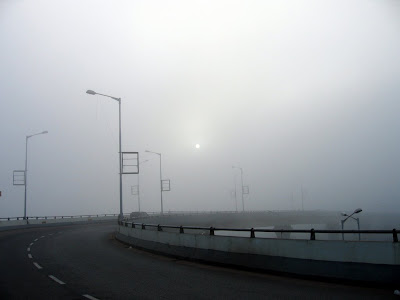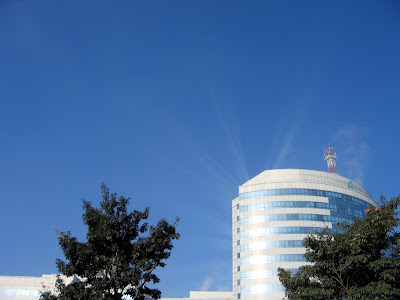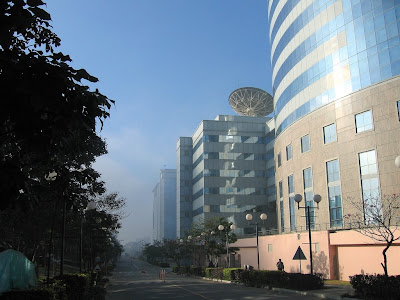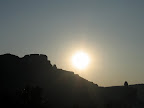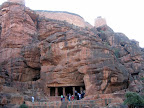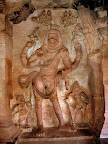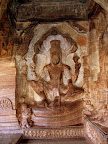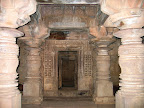Friday, January 18, 2008
Sunrise - Bangalore More Pictures
Thursday, January 17, 2008
Sunrise - Bangalore
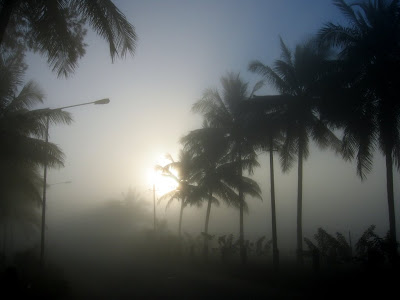
Agriculture University Campus (UAS)

Agriculture University Campus (UAS)
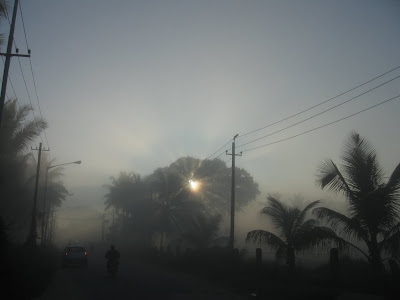
Agriculture University Campus (UAS)

Railway Line Near Hebbal

Hebbal Lake, Twin tower in the background

Twin towers
Tuesday, January 15, 2008
Badami
The place gets its name from the color of the rocks in the region. They are similar the color of the dry fruit – Badami and hence the name.
Badami has a number of temples built between the 5th and 8th century, the most famous among them are the cave temples. Due to time constraints and the fatigue of having traveled to Hampi, we decided only to visit these cave temples. There are 4 cave temples (plus one natural cave).
Chalukyas were predominantly followers of Lord Vishnu, however the latter kings were also followers of Lord Shiva. A few also embraced Jainism. This is evident from the 4 cave temples. The first one is dedicated to Lord Shiva, 2nd and 3rd dedicated to Lord Vishnu and the 4th one to Jainism. In the 5th (natural cave) there is a sculpture, though the exact identity of this carving is not know, it is though to resemble Lord Buddha.
The temples have been carved into the hills, except for the deities nothing in the temples is foreign. Everything has been carved into the finely grained horizontally stratified sandstone hills of Badami. Each of these temples are characterized by a pillared “mukha mutapa” (verandha), then a “maha mantapa” and then a small cell – the “garbha gudi” which houses the God.
The 3rd cave (from below) dedicated to Lord Vishnu is the oldest among the 4 caves. It is also the most grandest and the biggest of all the 4 caves. The main idol is missing (same is the case with the other Vishnu cave temple) – it is believed to have been destroyed in the 16th century during the muslim invasion. The sculptures and carvings here depict the various incarnations of Lord Vishnu including Bali Chakravarthi, Vijayanarasimha, Ranganatha among others.
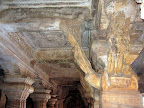
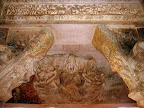
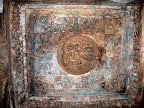
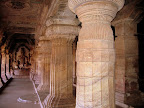
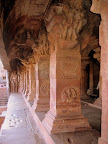

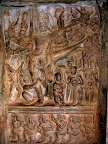
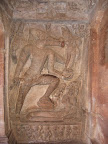
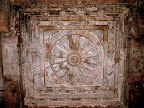



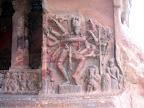
The 4th cave is dedicated to Jainism and consists of various Jain thirthankaras. Though not as big or as elaborate as the other 3 Hindu temples, the sculptures are very unique.



Depending on your interests it could take 2-3 hours to view these cave temples. There are other temples in the vicinity, which we skipped. To cover all of them it could take a couple of hours more. The film Guru was also shot in this area.
Close to Badami there is Banashankari Temple and Mahakuta temples. Unless you are deeply religious you may want to skip Banashankari Temple, but the Mahakuta temple complex is worth a visit. Both these places are with in 20km from Badami. Mahakuta was also one of the capitals of the Chalukyas. There are lot of Shiva temples in this complex.
More pictures below:
Monday, January 07, 2008
Aihole
Situated on the banks of the holy river Malaprabha (one of the 3 rivers that join at Kudalasangama) this town has more than 125 temples – with no two temples similar to each other. Infact many of the other architecture marvels of Karnataka including the ones at Badami, Pattadakalu, Belur, Halebidu, Somnathpura are based on the temples found in this place.
There is an interesting legend behind the name “Aihole”. Parshurama (the 6th avatara of Lord Rama) after one of his battles, washes his axe in the river Malaprabha, the blood on his axe turns the entire river into red. A lady who happens to be at the river at this instance, is shocked and starts shouting “aiyoo nana hole” (roughly translates to: Oh my river). Hence this place came to be known as “Aihole”. (This was what my guide told me.)
Inscription found there, indicate that during the 7th century this place also used to be a university for stone architecture. Much like modern day universities, this university used to grant “scholarships” to its students. This practice has been documented in one of the 7th century inscriptions found in one of the temples in Aihole. As a pre-requisite to successfully graduate from there the students had to construct a temple – this explains the vast no of temple in this area. This was the early phase of temple architecture in South India. It was the time when rules were yet to be defined. Each temple was an experiment; none of them are even remotely similar to each other.
This place is the foundation stone of the Dravidian and Jaina temple culture. The earliest temples were built here in the 5th century. The “Meguthi” temple here is the oldest dated structural temple in India, it was completed in 634 A.D. The inscriptions at this temple also take of the legendary poet and dramatist Kalidasa.
Aihole is the oldest of the 3 Chalukyan places – Aihole, Badami and Patadakallu. The temples here are spread over a vast region, and only a few are protected. It would take a few days to cover most of this rocky area. I spent less than an hour here and covered only 5 temples.
The external architecture of the Indian Parliament was based on the Durga temple. One look at this temple and the first thing that comes to your mind is the Parliament building. This not a temple dedicated to Goddess Durga as the name suggests. The temple is close to the fort and another name for the fort in kannada is durga or durgi and hence it got its name as Durga temple. It is a temple dedicated to Lord Vishnu (early Chalukyans were followers of Lord Vishnu – hence the majority of the temples here are dedicated to Lord Vishnu).
The main tourist place in Aihole is the Durga temple complex. There are around 4 temples with in this fort. And there is another temple (Ambigera Temple Complex) just on the other side of the road.
The sculptures here are very intrinsic and some are very exotic. The sculptures give a deep insight into the social life of the people. Every minute detail from the jewelry to the fashionable dress they wore has been documented in these sculptures. From the sculptures you could guess that short (and even mini) skirts were very popular at that time. Also special attention has been given to the sexual life of the people at that time. Episodes from Ramayana and Mahabharata have also been given great importance in the carvings here.
Unfortunately my camera batteries were drained out and I could take only a few pictures of this wonderful place. There is a KSTDC hotel near by; the food at this place is pretty good. They also have rooms to stay, but the facilities are very basic – there is no power during the day.
